
Pseudoplatystoma is a genus of several South American catfish species of family Pimelodidae. The species are known by a number of different common names. They typically inhabit major rivers where they prefer the main channels and tend to stay at maximum depth, but some species can also be seen in lakes, flooded forests, and other freshwater habitats. They have robust bodies, and are important food fish. Recently, their population size has been on the drastic decline due to a variety of factors including overfishing and habitat destruction due to the construction of hydroelectric dams.

Euploea mulciber, the striped blue crow, is a butterfly found in India and Southeast Asia that belongs to the crows and tigers, that is, the danaid group of the brush-footed butterflies family.

The West African catshark is a catshark of the family Scyliorhinidae. It is found in the eastern Atlantic between latitudes 20° N and 17° S, at depths between 45 and 500 m. It can grow up to a length of 80 centimetres (31 in). At one time, the West African catshark was considered to be a subspecies of the nursehound, Scyliorhinus stellaris, but is now considered to be a separate species. The reproduction of this catshark is oviparous.
The speckled swellshark is a little-known species of catshark, and part of the family Scyliorhinidae, endemic to the waters off northwestern Australia. It occurs on the outer continental shelf and upper continental slope, at a depth of 150–455 m (492–1,493 ft). This species grows to 69 cm (27 in) long and has a stocky body and a short, broad, flattened head. As its common name suggests, its color pattern consists of many dark spots and white-spotted dark saddles and blotches on a light gray background. The juveniles are yellow with dark spots and lines, and a distinctive eyespot-like mark behind each eye. Like other swellsharks, this species can inflate itself as a defensive measure.

Primitive markings are a group of hair coat markings and qualities seen in several equine species, including horses, donkeys, and asses. In horses, they are associated with primitive breeds, though not limited to such breeds. The markings are particularly associated with the dun coat color family. All dun horses possess at least the dorsal stripe, but the presence of the other primitive markings varies. Other common markings may include horizontal striping on the legs, transverse striping across the shoulders, and lighter guard hairs along the edges of a dark mane and tail.

Orectolobus reticulatus, the network wobbegong, is a recently described species of carpet shark found in relatively shallow waters off Kimberley and Darwin in north-western Australia. With a known maximum length of only 52.3 centimetres (20.6 in), it may be the smallest species of wobbegong. Until its description in 2008, it had been confused with the northern wobbegong. The network wobbegong has a short snout, broad head, elongated body, and two dorsal fins, with the first being slightly larger than the second. Its body is grayish brown with darker brown markings and a pale yellow underbelly. The network wobbegong lives in shallow waters along reefy bottoms.

Earophila badiata, the shoulder stripe, is a moth of the family Geometridae. The species was first described by Michael Denis and Ignaz Schiffermüller in 1775. It is found from most of Europe and North Africa to the Altai Mountains in the east Palearctic.

Parornix scoticella is a moth of the family Gracillariidae. It is known from all of Europe.

Cosmopterix clemensella is a moth of the family Cosmopterigidae. It is known from Canada and the United States.
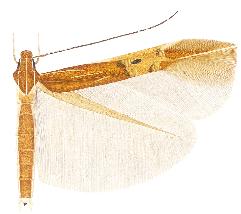
Cosmopterix fernaldella is a moth of the family Cosmopterigidae. It is known from the United States and Canada.

Cosmopterix inopis is a moth of the family Cosmopterigidae. It is known in the United States, from Arizona and Florida.
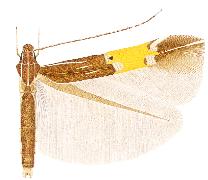
Cosmopterix magophila is a moth of the family Cosmopterigidae. It is known from the United States and the Dominican Republic.

Cosmopterix montisella is a moth of the family Cosmopterigidae. It is known from the United States, where it is found from New York and Oregon south to New Mexico, Arizona and California. Single specimens have been collected in Arkansas and Iowa. The species is now also established in Michigan.

Cosmopterix similis is a moth of the family Cosmopterigidae. It is known from the US Virgin Islands and the British Virgin Islands (Guana).
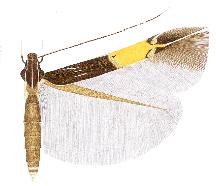
Cosmopterix teligera is a moth of the family Cosmopterigidae. It is known from the United States, Brazil, Colombia, Costa Rica, Cuba, Jamaica and Mexico (Tamaulipas).

Pebobs ipomoeae is a moth of the family Cosmopterigidae. It is known from Florida.
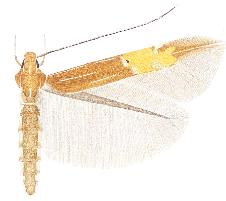
Pebobs sanctivincenti is a moth of the family Cosmopterigidae. It is known from Grenada and Saint Vincent and the Grenadines.
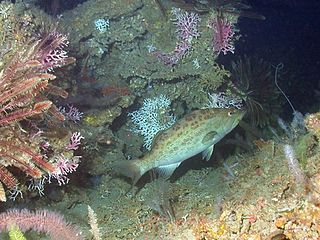
The scamp grouper, also known as scamp, is a species of marine ray-finned fish, a grouper from the subfamily Epinephelinae which is part of the family Serranidae, which also includes the anthias and sea basses. It is found in the western Atlantic Ocean.
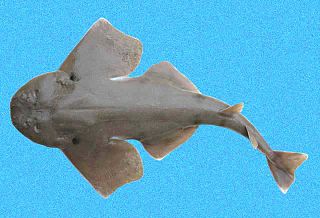
The disparate angelshark is a species of angelshark found along the East Coast of the United States and the Gulf of Mexico. It occurs at depths down to 1,290 m (4,230 ft) and reaches a length of 49 cm (19 in). Heteroptera in its name refers to the difference in size, shape and area of the two dorsal fins. Disparate angelsharks have the typical angel shark body form that is broadly flattened with large pectoral/pelvic fins and eyes and spiracles on the top of their heads. Their common and species name comes from them having dorsal fins of very different sizes, shapes, and areas compared to other angel sharks.
Zaniolepis frenata, also known as the shortspine combfish, is a species of ray-finned fish belonging to the family Zaniolepididae.The species occurs in the eastern Pacific Ocean.







